Sir John Monash, Personal Files Book 14, 1 December 1916 - 10 February 1917, Part 2
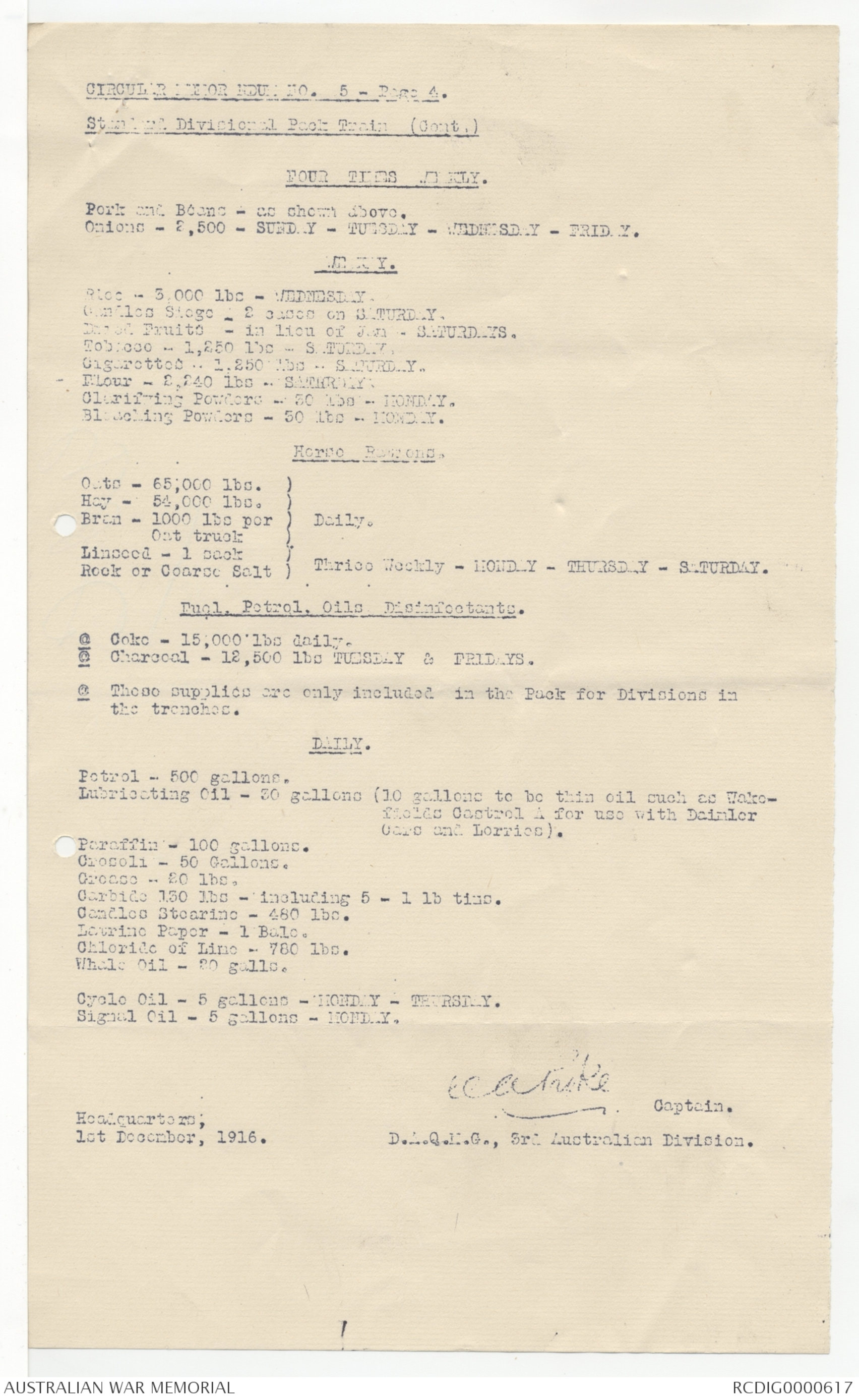

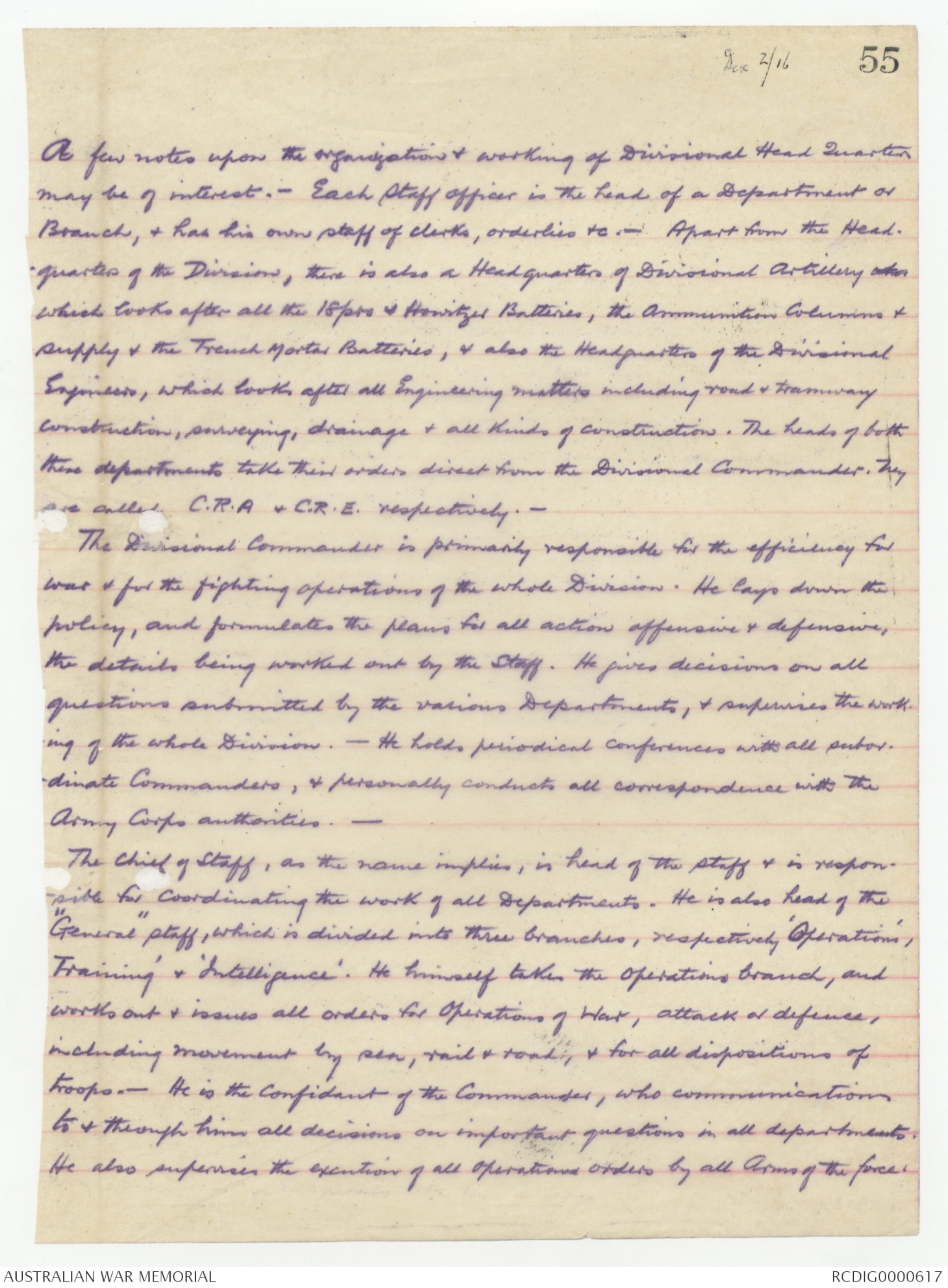
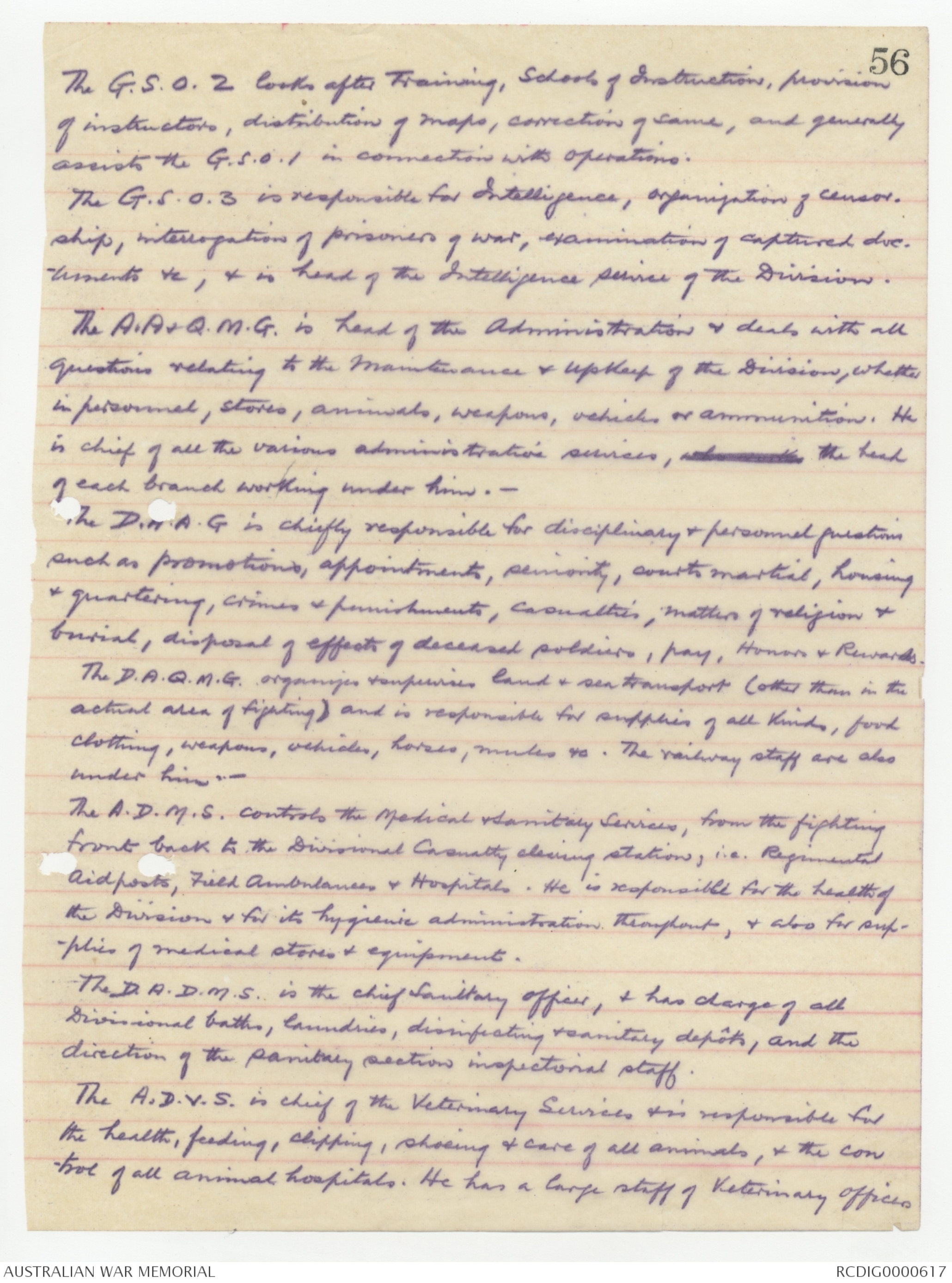
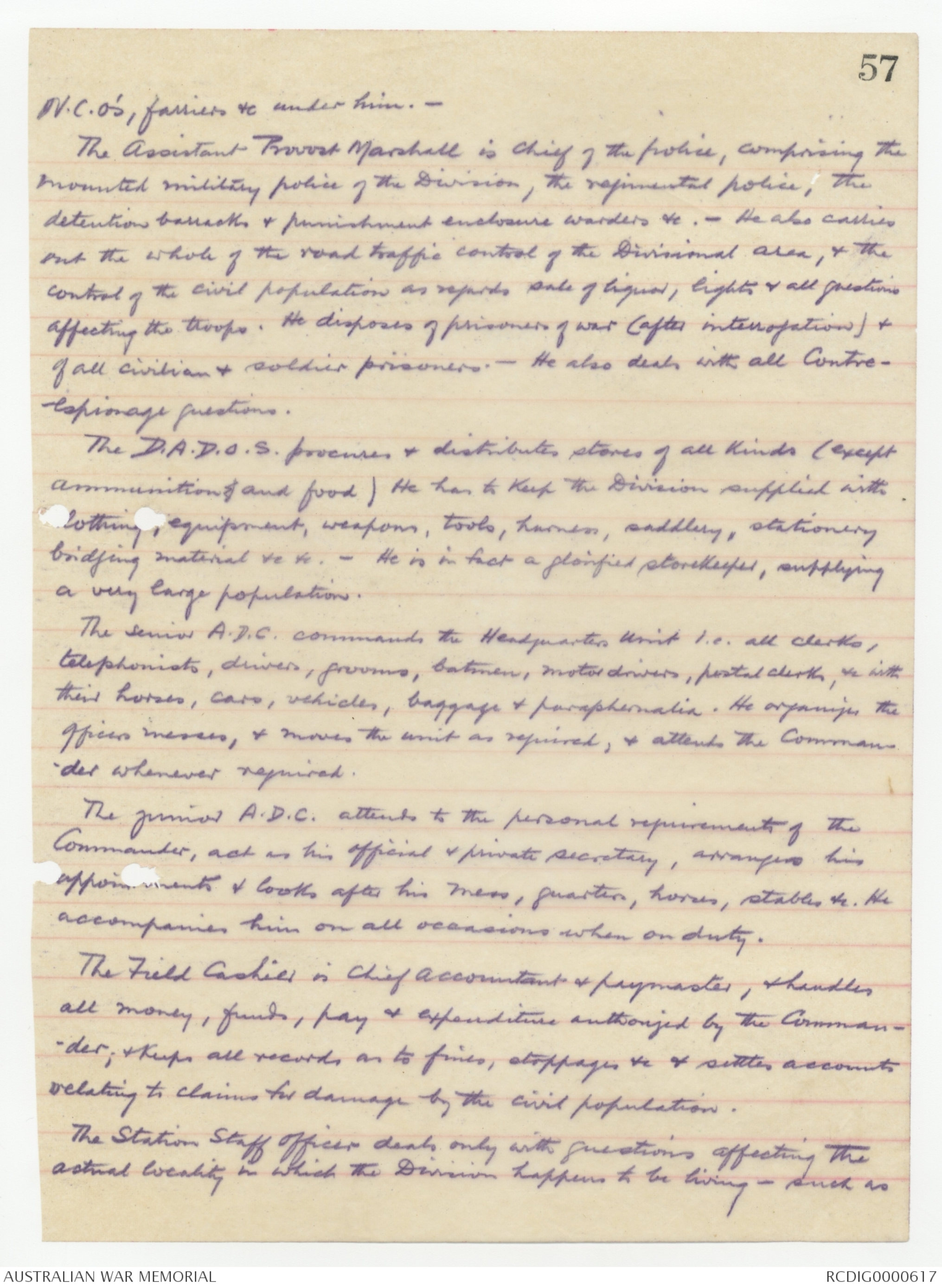
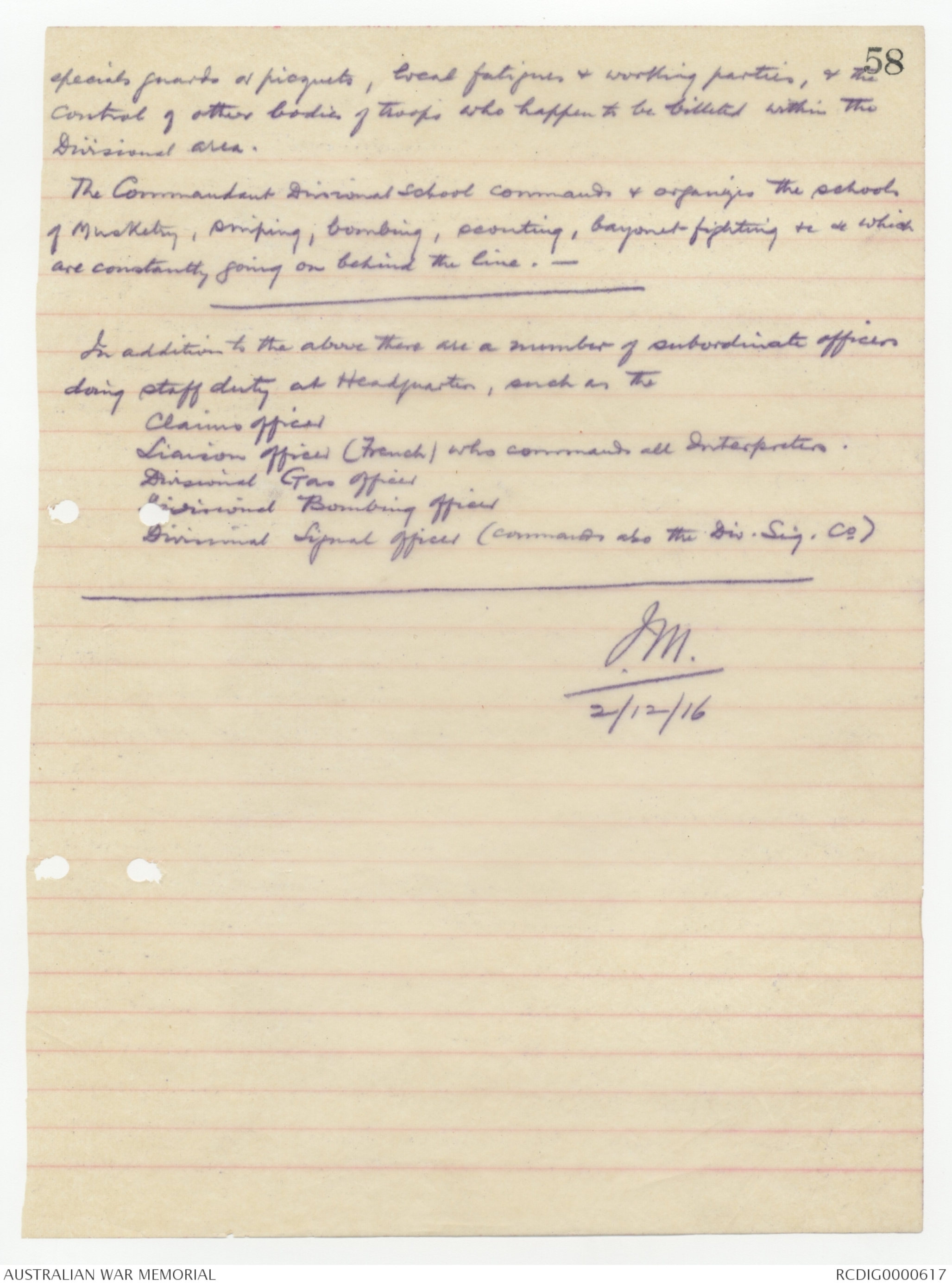

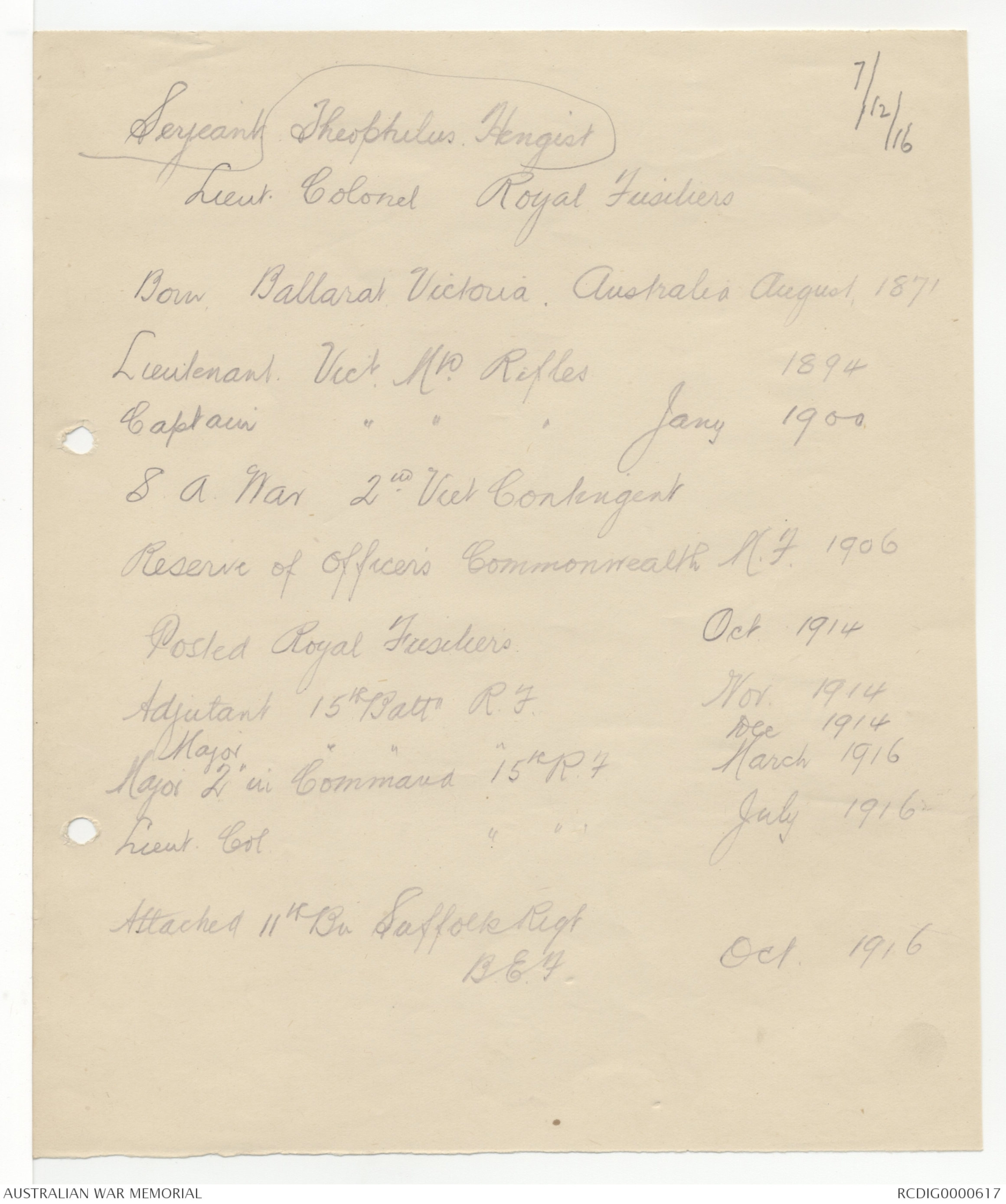
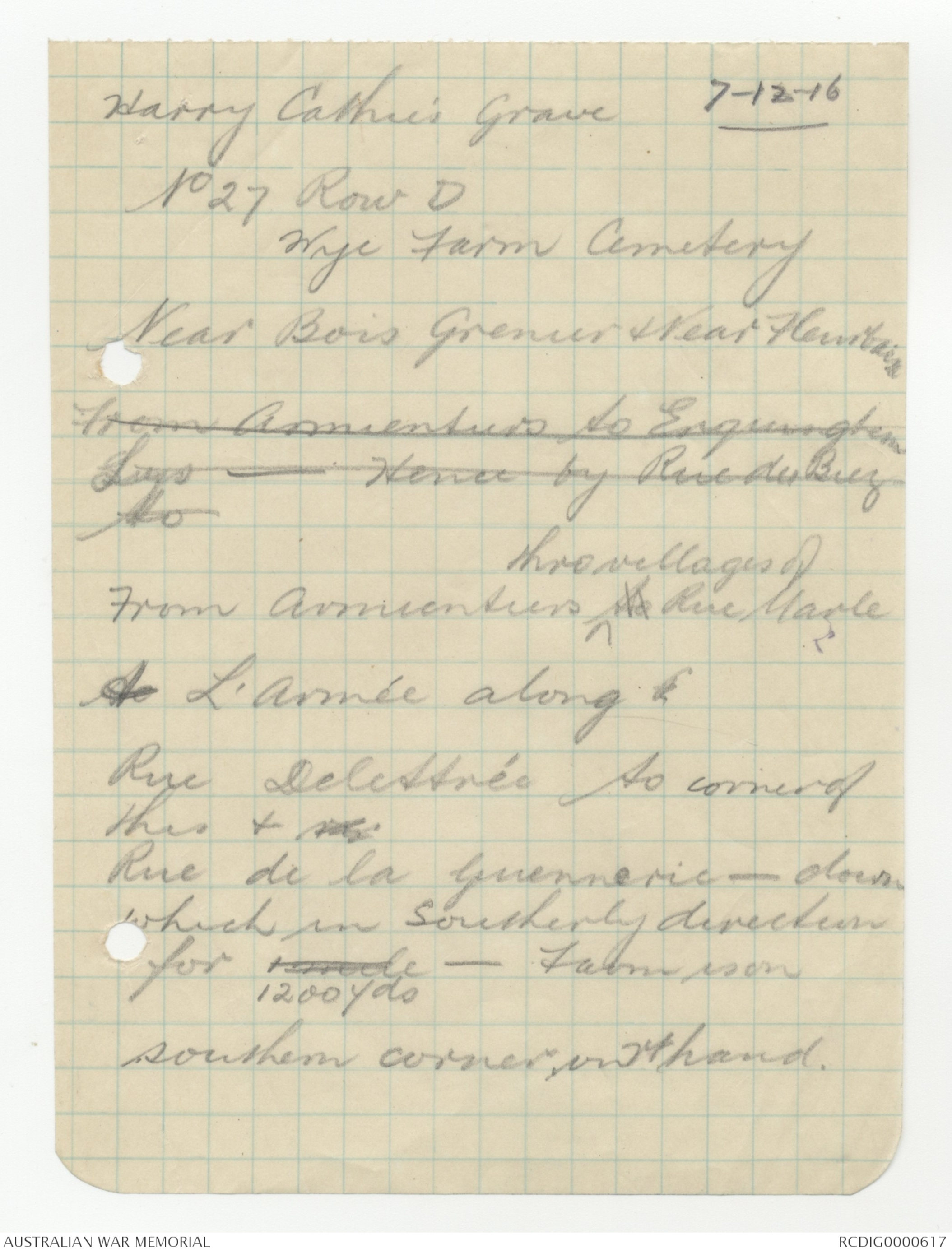
CIRCULAR MEMORANDUM NO. 5 - Page 4.
Standard Divisional Pack Train (Cont.)
FOUR TIMES DAILY.
Pork and Beans - as shown above.
Onions - 2,500 - SUNDAY - TUESDAY - WEDNESDAY - FRIDAY.
WEEKLY
Rice - 3,000 lbs - WEDNESDAY
Candles Siege - 2 cases on SATURDAY.
Dried Fruits - in lieu of Jam - SATURDAYS.
Tobacco - 1,250 lbs - SATURDAY.
Cigarettes - 1,200 lbs - SATURDAY.
Flour - 2,240 lbs - SATURDAY.
Clarifying Powders - 30 lbs - MONDAY.
Bleaching Powders - 50 lbs - MONDAY.
Horse Rations.
Oats - 65,000 lbs. )
Hay - 54,000 lbs. )
Bran - 1000 lbs per ) Daily.
Oat truck )
Linseed - 1 sack )
Rock or Coarse Salt ) Thrice Weekly - MONDAY - THURSDAY - SATURDAY.
Fuel, Petrol, Oils Disinfectants.
@ Coke - 15,000 lbs daily.
@ Charcoal - 12,500 lbs TUESDAY & FRIDAYS.
@ These supplies are only included in the Pack for Divisions in
the trenches.
DAILY.
Petrol - 500 gallons.
Lubricating Oil - 30 gallons (10 gallons to be thing oil such as
Wakefields Castrol A for use with Daimler
Cars and Lorries.)
Paraffin - 100 gallons.
Grosoli - 50 Gallons.
Grease - 20 lbs.
Carbide 130 lbs - including 5 - 1 lb tins.
Candles Stearine - 480 lbs.
Latrine Paper - 1 Bale.
Chloride of Lime - 780 lbs.
Whale Oil - 20 galls.
Cycle Oil - 5 gallons - MONDAY - THURSDAY.
Signal Oil - 5 gallons - MONDAY.
ECA Proke
Captain.
D.A.Q.M.G., 3rd Australian Division.
Headquarters,
1st December, 1916.
1/12/16
QUESTIONS TO BE NOTED WHEN GOING ROUND TRENCHES.
1. Dug-out accommodation. 25% of Battalion in front line,
and dug-outs for 150 men per 1,000 yards of front.
2. Wire.
3. Parapet.
4. Log books.
5. Gas gongs.
6. General system.
7. Dangerous points.
8. Action if heavily shelled.
9. Ruses.
10. Work in area.
11. Positions of trench mortars, machine guns, stores, &c.
12. Positions of Headquarters.
13. Means of communication and rules as to use of telephones.
14. No Man's Land.
15. Snipers and observation posts.
16. Cooking and feeding of the men.
17. Supply of material.
18. Vemoral sprayers.
19. Where to raid.
20. Position of hostile Minnies and mine shafts.
21. Where firing at night is done from our gaps.
22. What line "D" Battalions, &e., would reinforce by, and
system of guides and emergency roads.
23. Periscopes
24. Periscopic Rifles
Dec 2/16 55
A few notes upon the organisation & working of Divisional Head Quarters
may be of interest. - Each staff officer is the head of a Department or
Branch, & has his own staff of clerks, orderlies &c.- Apart from the Headquarters
of the Division, there is also a Headquarters of Divisional Artillery xxx
which looks after all the 18prs & Howitzer Batteries, the Ammunition Columns &
supply & the French Mortar Batteries, & also the Headquarters of the Divisional
Engineers, which looks after all Engineering matters including road & tramway
construction, surveying, drainage & all kinds of constructions. The heads of both
these departments take their orders direct from the Directional Commander. They
are called C.R.A & C.R.E. respectively. -
The Divisional Commander is primarily responsible for the efficiency for
war & for the fighting operations of the whole Division. He lays down the
policy, and formulates the plans for all action affirmative & defensive,
the details being worked out by the Staff. He gives decisions on all
questions submitted by the various Departments, & supervises the working
of the whole Division. - He holds periodical conferences with all subordinate
Commanders, & personally conducts all correspondence with the
Army Corps authorities. -
The Chief of Staff, as the name implies, is head of the staff & is responsible
for Coordinating the work of all Departments. He is also head of the
"General" staff, which is divided into three branches, respectively 'Operations',
'Training' & 'Intelligence'. He himself takes the Operations branch, and
works out & issues all orders for Operations of War, attack or defence,
including movement by sea, rail & road, & for all dispositions of
troops.- He is the Confidant of the Commander, who communications
to & through him all decisions on important questions in all departments.
He also supervises the execution of all Operations orders by all Army of the forces.
56
The G.S.O.2 looks after training, Schools of Instructions, provisions
of instructors, distribution of maps, corrections of same, and generally
assists the G.S.O.1 in connections with operations.
The G.S.O.3 is responsible for Intelligence, organisation of censorship,
interrogation of prisoners of war, examination of captured determents
&c, & is head of the Intelligence service of the Divisions.
The A.A & Q.M.G. is the head of the Administration & deals with all
questions relating to the Maintenance & upkeep of the Division, whether
in personnel, stores, animals, weapons, vehicles or ammunition. He
is chief of all the various administrative services, who works the head
of each branch working under him. -
The D.H.A.G is chiefly responsible for disciplinary & personnel function
such as promotions, appointments, seniority, courts martial, housing
& quartering, crimes & punishment, casualties, matters of religion &
burial, disposal of effects of deceased soldiers, pay, Honors & Rewards.
The D.A.Q.M.G. organises & supervises land & sea transport (other than in the
actual area of fighting) and is responsible for supplies of all kinds, food
clothing, weapons, vehicles, horses, mules &c. The railway staff are also
under him. -
The A.D.M.S. controls the Medical & Sanitary services, from the fighting
front back to the Divisional Casualty clearing stations, i.e. Regimental
Aidposts, Field Ambulances & Hospitals. He is responsible for the health of
the Division & for its hygienic administration throughout, & also for the
supplies of medical stores & equipment.
The D.A.D.M.S. is the chief sanitary officer, & has charge of all
Divisional baths, laundries, disinfecting & sanitary depots, and the
direction of the sanitary section inspectorial staff.
The A.D.V.S is chief of the Veterinary Services & is responsible for
the health, feeding, clipping, shoeing & care of all animals & the control
of all animal hospitals. He has a large staff of Veterinary Officers
57
N.C.O's, farriers &c under him.-
The Assistant Provost Marshall is Chief of the police, comprising the
mounted military police of the Division, the regimental police, the
detention barracks & punishment enclosure wardens &c. - He also carries
out the whole of the road traffic control of the Divisional area, & the
control of civil population as regards sale of liquor, lights & all questions
affecting the troops. He disposes of prisoners of war (after interrogation) &
of all civilian & soldier prisoners. - He also deals with all Contre-espionage
questions.
The D.A.D.O.S. procures & distributes stores of all kinds (except
ammunition and food) He has to keep the Division supplied with
clothing, equipment, weapons, tools, harness, saddlery, stationery
bridging material &c &c. - He is in fact a glorified storekeeper, supplying
a very large population.
The Senior A.D.C. commands the Headquarters Unit i.e. all clerks,
telephonists, drivers, grooms, batmen, motor drivers, postal clerks, &c with
their horses, cars, vehicles, baggage & paraphernalia. He organises the
officers messes, & moves the unit as required, & attends the Commander
whenever required.
The junior A.D.C. attends to the personal requirements of the
Commander, act as his official & private secretary, arranges his
appointments & looks after his mess, quarters, horses, stables &c. He
accompanies him on all occasions when on duty.
The Field Cashier is Chief Accountant & paymaster, & handles
all money, funds, pay & expenditures authorised by the Commander,
& keep all records as to fines, stoppages &c & settles accounts
relating to claims for damage by the civil population.
The Station Staff Officer deals only with questions affecting The
actual locality in which the Division happens to be living - such as
58
special guards or picquets, local fatigues & working parties, & the
control of other bodies of troops who happen to be billeted within the
Divisional area.
The Commandant Divisional School commands & organises the schools
of Musketry, sniping, bombing, scouting, bayonet fighting &c &c which
are constantly going on behind the line. -
_____________________
In addition to the above there are a number of subordinate officers
doing staff duty at Headquarters, such as The
Claims officer
Liaison officer (French) who commands all Interpreters
Divisional Gas Officer
Divisional Bombing Officer
Divisional Signal Officer (commands also the Div. Sig. Co)
___________________________________
JM
2/12/16
G 36/7
THIRD AUSTRALIAN DIVISION
Divisional Headquarters, 4/12/16.
REPORT ON TRAM LINES IN THE LEFT DIVISIONAL SECTOR OF THE CORPS
FRONT.
Existing lines are shewn on the tracing attached to this report.
They are all above ground and run along old roadways. The portions
over which stores and supplies are carried are marked on the attached
tracing by a 'cross' at either end. Dumps exist at points marked
thus: - (x) The rails are partly iron and partly wood. As a
general rule, at the western end of each line the rails are iron,
at the eastern end wood in order to avoid noise. The tramline from
C.28.b.7.4 to C.28.d.8.7. is out of repair and unfit for use.
Allowing for "a", "b" and half of "c" Battalions being east of a
line through CHAPELLE D'ARMENTIERES - HOUPLINES. the carrying
capacity of the tramlines in this sector per day should be roughly
as follows. -
For supplies 16,000 lbs.
For Ammunition & Bombs. 27,000 lbs.
For Engineer Material. 50,000 lbs.
Rolling stock at present available consists of 85 trolleys,
partly flat measuring 6' by 4' for carrying engineer material and
partly boxes for carrying rations &c; the latter measure 5' by
3' by 1 1/2'. A better shaped trolley might be introduced more nearly
co-inciding with the shape of communication trenches.
Two schemes of tramlines seem to be possible. -
No. 1 An extension of the present line over-ground.
No. 2 Conversion of to a trench system.
Little work would be required to make the present overground
system useful, but the disadvantages of this system are
that the enemy, by keeping fixed rifles and machine guns on the
various tracks, could completely prevent supplies being xxxxxxxxx
brought up; thus, carrying parties might have to be constantly
resorted to at short notice. If, however, this system is to
be adhered to, it is recommended that a branch should be run
along the road from I.9.b.2.9. to C.28.a.4.1. with radiating
lines to GRANDE PORT EGAL FARM and to point I.5.c.2.1. This
circular traffic to PORT EGAL FARM and trenches in the vicinity.
L'EPINETTE trenches would be supplied by terminal traffic and
PORT BALLOT trenches could be supplied by circular traffic if
the section of the line about PORT BALLOT is repaired.
EDMEADS FARM section and LA RUAGE section might remain as at
present. With overland trams, mule haulage could be used;
with Trench Tramways it could not. If the latter system is
adopted, petrol engines or man power are the only available
means of propulsion. If it is decided to improve the tramline
system in the left sector of the Corps front, the question of
using the town trams from refilling point to forward dumps at
HOUPLINES might be considered. If used, these lines would largely
reduce the amount of animal haulage necessary. But the system
would necessitate adherence to special roads through ARMENTIERES,
which, in the event of heavy shelling could not be avoided by
making detours as at present.
If a system of trench tramways is to be adopted, it is
recommended that a complete transverse line shall be run along
the existing traffic trench at the back of the Subsidiary line.
This trench is sufficiently broad to carry a tramline, and the
establishment of such a line would not necessitate a vast amount
of work. As regards trenches suitable for joining up with this
line, rails could be laid in DURHAM AVENUE without much difficult
and then could be continued along SUSSEX AVENUE, LUNATIC AVENUE
could also be adapted for a tram line. EDMEADS AVENUE is too
narrow, WESSEX, GLOUCESTER, SPAIN, BUTERNE, CENTRAL, and LOTHIAN
thus, a large amount of work would be necessary to develop a
thorough system of trench tram lines.
G. H. Jackson
Lieut-Colonel,
General Staff.
7/12/16
Sergeant Theophilus Hengist
Lieut. Colonel Royal Fusiliers
Born Ballarat Victoria. Australia August 1871
Lieutenant Vict. Mtd Rifles. 1894
Captain. " " " Jany 1900
S A War 2nd Vict Contingent
Reserve of Officer's Commonwealth N.F. 1906
Posted Royal Fusiliers Oct 1914
Adjutant 15th Battn R.F. Nov 1914
Major " " " Dec 1914
Major 2 "in" Command 15th R.F. March 1916
Lieut. Col. " " July 1916
Attached 11th Bn Suffolk Regt
B.E.F. Oct 1916
Harry Cathies Grave 7-12-16
No 27 Row D
Wye Farm Cemetery
Near Bois Grenier & Near Fleurbaix
From Armentieres to Erquinghem
Lys - Hence by Rue du Biez
xxxx
From Armentieres ^thro villages of xx Rue Marle
A L'Arméé along to
Rue Delettréc to corner of
this & xx
Rue de la Guenneric - down
which is Southerly direction
for xxxyds ^1200yds - Farm is on
southern corner, on rt hand.
 Loretta Corbett
Loretta CorbettThis transcription item is now locked to you for editing. To release the lock either Save your changes or Cancel.
This lock will be automatically released after 60 minutes of inactivity.